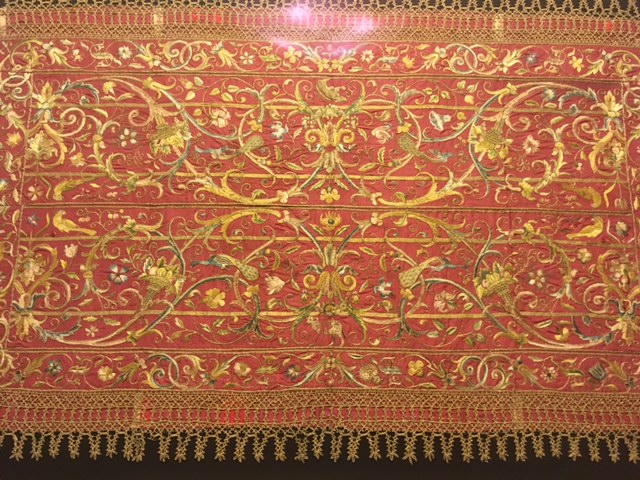|
My mom taught me how to sew when I was in elementary school. My first project was a picture of a cat with a phrase underneath it, a sampler of sorts. At first, I was afraid to make mistakes. I cautiously traced the iron-on transfer pattern with bright, glossy thread. I started to pick up speed and skill with practice. It amazed me how one stitch repeated to create something bigger with more meaning. Over time, I improved and sewed more elaborate projects. When I was in middle school, I loved to embellish my low-rise flared jeans. Textured flowers and flowing words trailed my needle like a silky comet in my denim galaxy. Hippies had nothing on my embroidered bell bottoms! I made the project shown above when I was researching the history of samplers. I copied the pattern from a photo of an antique sampler in a reference book, but I added my own twist to the design. I learned that a girl made a sampler as a library of stitches and a display of her embroidery artistry. Sometimes sewing a sampler was a girl’s first exposure to numbers and the alphabet. Some of the first small businesses owned by women focused on sewing.
The Industrial Revolution took the capital and tools necessary to create things away from the masses and concentrated it in the hands of just a few firms. Technology developed in the past few decades has democratized the opportunity to be able to manufacture products. With advances in desktop 3D printing and the internet to connect creators with both customers and investors, small business is back. It’s our time! Over the years, I’ve continued to make samplers because of their historical significance as a means for women to learn how to read and write, express their creativity, and achieve economic independence. Crafting is art! Making samplers embodies my love of learning and belief in the power of women.
2 Comments
I was looking at an ornate medieval tapestry in a museum when I realized creating something beautiful or innovative is an enormous investment of time. Making an amazing idea manifest as a physical reality often requires immersing oneself in the alternate reality of solitude.
I wondered if the unknown artist sacrificed something to make her masterpiece. Was sewing obligatory or did she do it as a hobby? Was she the lady of a manor sewing with a circle of friends or did she stitch in the cloistered silence of an abbey? How many years did it take her to complete the beautiful art I was viewing? I’ll never know the answers to my questions, but I know part of the woman lives on in her work. She immortalized the values and culture of her era from her perspective and according to her tastes in a time when men dominated literature and the arts and suppressed the female viewpoint. There’s no questioning her talent. |
Hello, there!
Thanks for visiting! Archives
February 2024
Categories |

 RSS Feed
RSS Feed